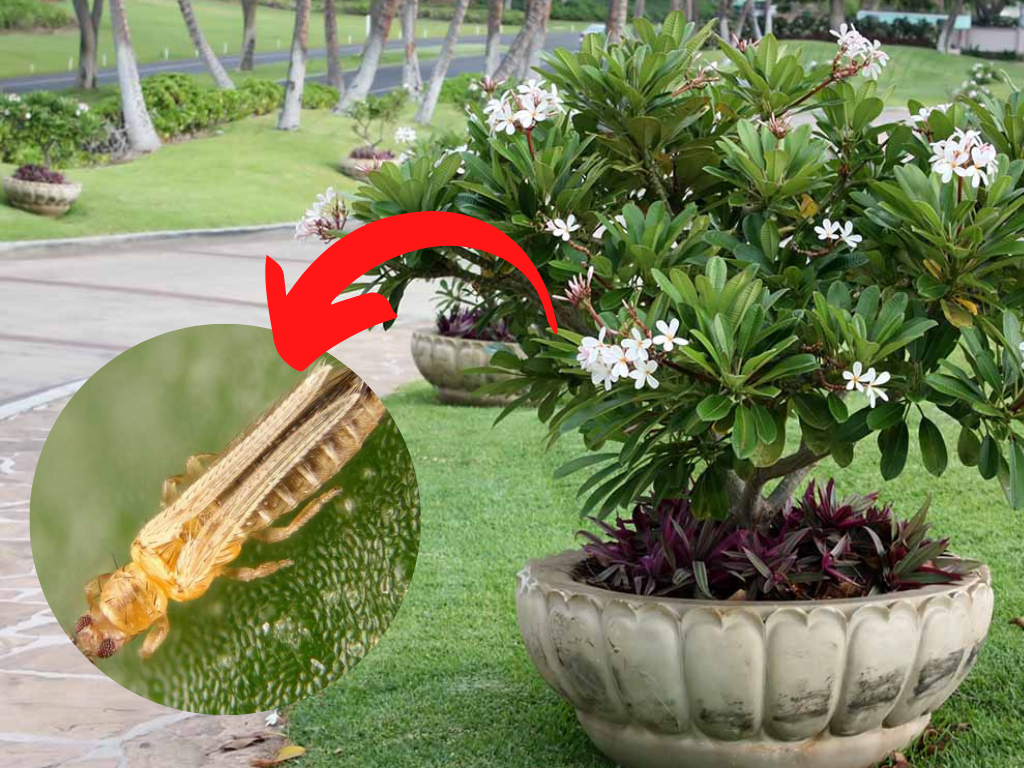
Like any other plant, plumeria is prone to various pest infestations. If your plumeria plant is kept in the correct environmental circumstances and you are worried about your plant's leaves becoming yellow and its flowers not opening, it's possible that your plant has a thrips infestation.
What are thrips?
Often known as thunder flies, thrips are small insects about the size of a fat sewing needle that feed by sucking on plants, greatly harming them, and even spreading viruses from one plant to another. The size and shape of each of the more than 6000 thrips species found in the wild vary. The typical garden thrip is between 0.5 and 5mm long. Thrips pierce the plant's outer layer with their mouthparts or stingers in order to get sap from it. Some thrips have even been observed puncturing the bodies of other insects and animals to suck bodily fluids.
How to identify a thrip infestation on plumeria leaves?
You must inspect the buds on your plumeria plant if you think it has a thrips infestation right now. Thrips typically live in the plumeria plant's buds. If you take a bud and put it on a transparent plate, you'll observe really small, black creatures that resemble rye seeds creeping out of the flower bed. Thrips can be black, brown, or yellow in color and are incredibly tiny.
Usually, when you get close to them, they fly or leap away. On the underside of the leaves, plumeria assembles in massive clusters. If you see brown spots or other colour changes on your plumeria plant's leaves, it's possible that bugs are hiding there and you should get rid of them.
Signs of thrip infestation on plumeria leaves:
Signs of thrip infestation on plumeria leaves include-
Discoloration- The earliest indications of a thrip infestation are black spots or translucent discoloration of the leaves. Papery and wrinkled texture- Thrip infestation is characterized by papery and dull leaves because thrips suck the sap from healthy leaves.
What causes thrips on plumerias?
When you add an already-infested plant to your existing plants, you risk getting a thrips infestation in your garden. Weeds are a thrips' natural host, so gardens that are surrounded by them are more likely to experience thrip infestation. Similar to this, thrip infestations thrive in gardens with a lot of ground debris.
How to treat thrips on plumeria?
Let's look at some safe, eco-friendly insecticides and treatments that are efficient at getting rid of thrips on plumeria.
Organic Pesticides and Pest Treatments
Spinosad and neem oil- Rub insecticidal soaps made from naturally occurring plant oils and fats to treat a thrip infestation. This is quite harmless for the plant and the soil. Neem oil and spinosad are secure oils that can be used to treat badly infested areas because they are obtained organically.
Diatomaceous Earth- Diatomaceous earth is a spiky, rough, and abrasive combination made from several insects' exoskeletons. Thrips are naturally eliminated by the plant's drying impact on them. To disturb their life cycle, simply put it on the soil and sprinkle it over the affected regions.
PyGanic- A natural insecticide obtained from chrysanthemum flowers is called pyrethrin. It is used commercially to get rid of thrips and other insects and often comes in a spray container.
Essential oils- Rosemary, peppermint, and lemongrass essential oils work as a natural pesticide against thrips on planets when combined with water.
How to prevent your plants from getting infested with thrips?
Though you can lessen their population, thrips infestations on your plants are impossible to completely prevent. Take the following precautions to lower the chances of your plumeria plant developing a thrips infestation:
-
Planting plants that attract thrips' natural predators will help keep your plumeria plant free of thrips.
-
Use reflective mulches to protect your plant from thrips by concealing it.
-
Plant vegetation that is naturally thrips-resistant.
-
Don't fertilize your plants excessively.
-
You can use a suitable soap and water solution to wash your indoor houseplants.
-
Water and clean outdoor plants using a hose.
-
Use a fine mesh screening to protect your plumeria plants.
-
Prune your garden frequently. In order to prevent thrips from breeding in your garden, make sure that there are no weeds growing there.









